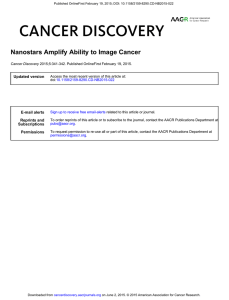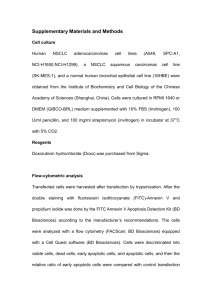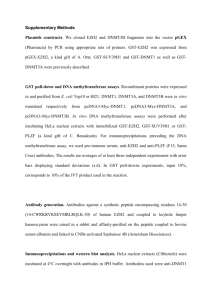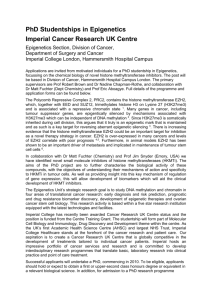A Potential Epigenetic Therapy for NSCLC Nanostars Amplify Ability
advertisement
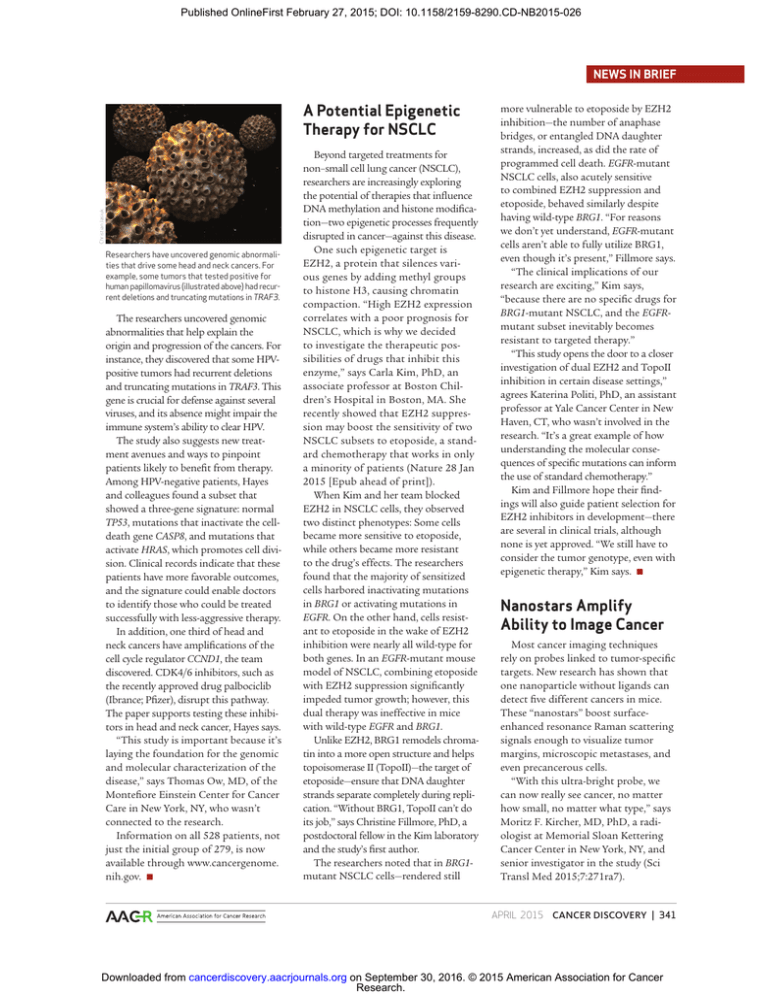
Published OnlineFirst February 27, 2015; DOI: 10.1158/2159-8290.CD-NB2015-026 NEWS IN BRIEF Christian Jasiuk A Potential Epigenetic Therapy for NSCLC Researchers have uncovered genomic abnormalities that drive some head and neck cancers. For example, some tumors that tested positive for human papillomavirus (illustrated above) had recurrent deletions and truncating mutations in TRAF3. The researchers uncovered genomic abnormalities that help explain the origin and progression of the cancers. For instance, they discovered that some HPVpositive tumors had recurrent deletions and truncating mutations in TRAF3. This gene is crucial for defense against several viruses, and its absence might impair the immune system’s ability to clear HPV. The study also suggests new treatment avenues and ways to pinpoint patients likely to benefit from therapy. Among HPV-negative patients, Hayes and colleagues found a subset that showed a three-gene signature: normal TP53, mutations that inactivate the celldeath gene CASP8, and mutations that activate HRAS, which promotes cell division. Clinical records indicate that these patients have more favorable outcomes, and the signature could enable doctors to identify those who could be treated successfully with less-aggressive therapy. In addition, one third of head and neck cancers have amplifications of the cell cycle regulator CCND1, the team discovered. CDK4/6 inhibitors, such as the recently approved drug palbociclib (Ibrance; Pfizer), disrupt this pathway. The paper supports testing these inhibitors in head and neck cancer, Hayes says. “This study is important because it’s laying the foundation for the genomic and molecular characterization of the disease,” says Thomas Ow, MD, of the Montefiore Einstein Center for Cancer Care in New York, NY, who wasn’t connected to the research. Information on all 528 patients, not just the initial group of 279, is now available through www.cancergenome. nih.gov. ■ Beyond targeted treatments for non–small cell lung cancer (NSCLC), researchers are increasingly exploring the potential of therapies that influence DNA methylation and histone modification—two epigenetic processes frequently disrupted in cancer—against this disease. One such epigenetic target is EZH2, a protein that silences various genes by adding methyl groups to histone H3, causing chromatin compaction. “High EZH2 expression correlates with a poor prognosis for NSCLC, which is why we decided to investigate the therapeutic possibilities of drugs that inhibit this enzyme,” says Carla Kim, PhD, an associate professor at Boston Children’s Hospital in Boston, MA. She recently showed that EZH2 suppression may boost the sensitivity of two NSCLC subsets to etoposide, a standard chemotherapy that works in only a minority of patients (Nature 28 Jan 2015 [Epub ahead of print]). When Kim and her team blocked EZH2 in NSCLC cells, they observed two distinct phenotypes: Some cells became more sensitive to etoposide, while others became more resistant to the drug’s effects. The researchers found that the majority of sensitized cells harbored inactivating mutations in BRG1 or activating mutations in EGFR. On the other hand, cells resistant to etoposide in the wake of EZH2 inhibition were nearly all wild-type for both genes. In an EGFR-mutant mouse model of NSCLC, combining etoposide with EZH2 suppression significantly impeded tumor growth; however, this dual therapy was ineffective in mice with wild-type EGFR and BRG1. Unlike EZH2, BRG1 remodels chromatin into a more open structure and helps topoisomerase II (TopoII)—the target of etoposide—ensure that DNA daughter strands separate completely during replication. “Without BRG1, TopoII can’t do its job,” says Christine Fillmore, PhD, a postdoctoral fellow in the Kim laboratory and the study’s first author. The researchers noted that in BRG1mutant NSCLC cells—rendered still more vulnerable to etoposide by EZH2 inhibition—the number of anaphase bridges, or entangled DNA daughter strands, increased, as did the rate of programmed cell death. EGFR-mutant NSCLC cells, also acutely sensitive to combined EZH2 suppression and etoposide, behaved similarly despite having wild-type BRG1. “For reasons we don’t yet understand, EGFR-mutant cells aren’t able to fully utilize BRG1, even though it’s present,” Fillmore says. “The clinical implications of our research are exciting,” Kim says, “because there are no specific drugs for BRG1-mutant NSCLC, and the EGFRmutant subset inevitably becomes resistant to targeted therapy.” “This study opens the door to a closer investigation of dual EZH2 and TopoII inhibition in certain disease settings,” agrees Katerina Politi, PhD, an assistant professor at Yale Cancer Center in New Haven, CT, who wasn’t involved in the research. “It’s a great example of how understanding the molecular consequences of specific mutations can inform the use of standard chemotherapy.” Kim and Fillmore hope their findings will also guide patient selection for EZH2 inhibitors in development—there are several in clinical trials, although none is yet approved. “We still have to consider the tumor genotype, even with epigenetic therapy,” Kim says. ■ Nanostars Amplify Ability to Image Cancer Most cancer imaging techniques rely on probes linked to tumor-specific targets. New research has shown that one nanoparticle without ligands can detect five different cancers in mice. These “nanostars” boost surfaceenhanced resonance Raman scattering signals enough to visualize tumor margins, microscopic metastases, and even precancerous cells. “With this ultra-bright probe, we can now really see cancer, no matter how small, no matter what type,” says Moritz F. Kircher, MD, PhD, a radiologist at Memorial Sloan Kettering Cancer Center in New York, NY, and senior investigator in the study (Sci Transl Med 2015;7:271ra7). APRIL 2015CANCER DISCOVERY | 341 Downloaded from cancerdiscovery.aacrjournals.org on September 30, 2016. © 2015 American Association for Cancer Research. Published OnlineFirst February 27, 2015; DOI: 10.1158/2159-8290.CD-NB2015-026 A Potential Epigenetic Therapy for NSCLC Cancer Discovery 2015;5:341. Published OnlineFirst February 27, 2015. Updated version E-mail alerts Reprints and Subscriptions Permissions Access the most recent version of this article at: doi:10.1158/2159-8290.CD-NB2015-026 Sign up to receive free email-alerts related to this article or journal. To order reprints of this article or to subscribe to the journal, contact the AACR Publications Department at pubs@aacr.org. To request permission to re-use all or part of this article, contact the AACR Publications Department at permissions@aacr.org. Downloaded from cancerdiscovery.aacrjournals.org on September 30, 2016. © 2015 American Association for Cancer Research.
